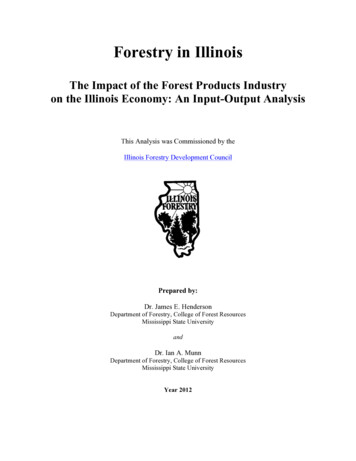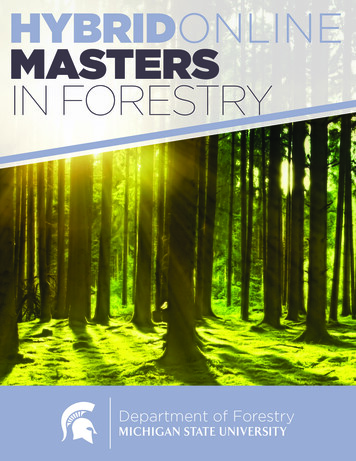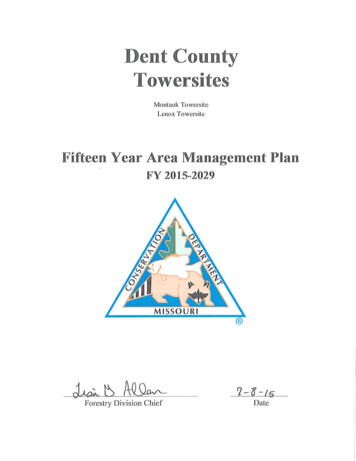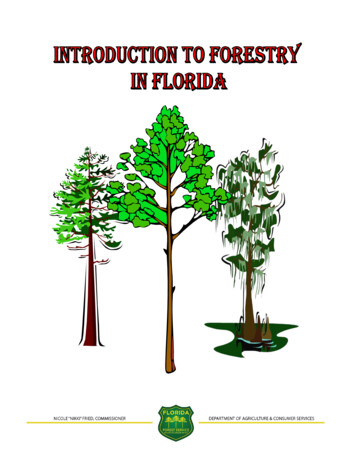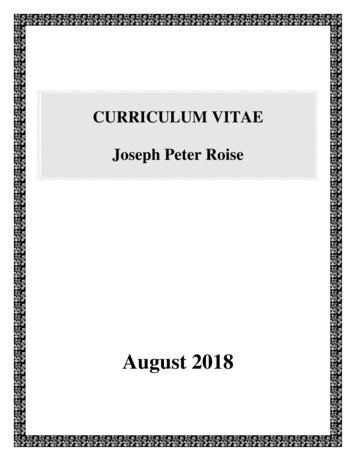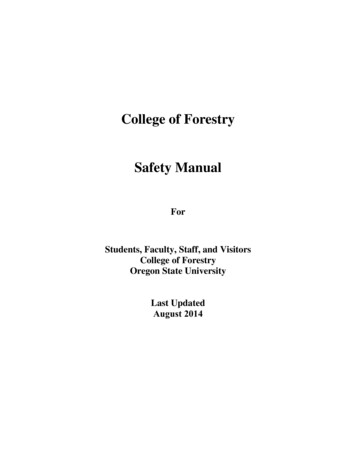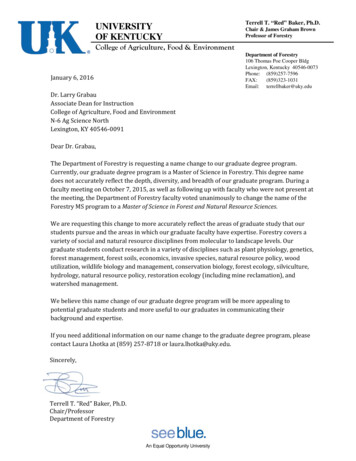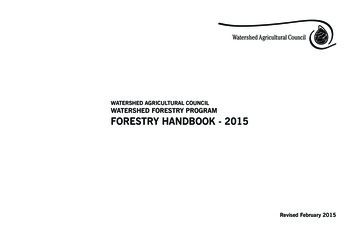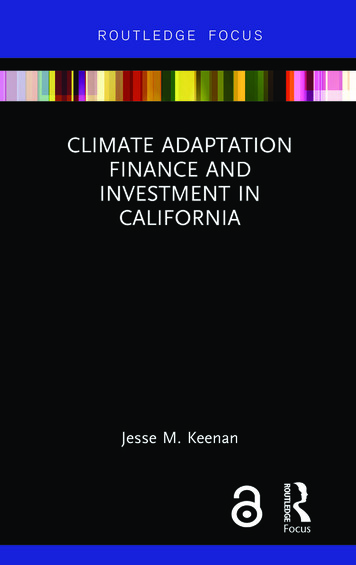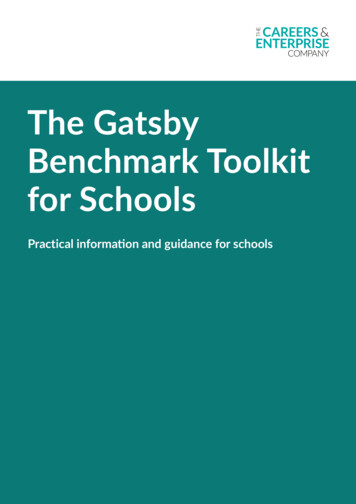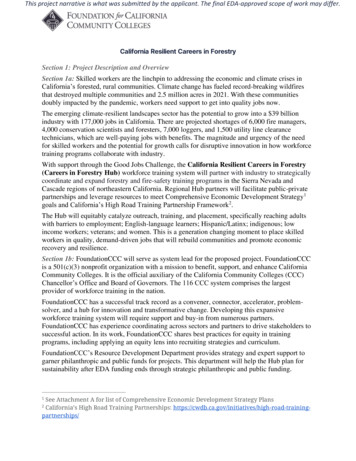
Transcription
This project narrative is what was submitted by the applicant. The final EDA-approved scope of work may differ.California Resilient Careers in ForestrySection 1: Project Description and OverviewSection 1a: Skilled workers are the linchpin to addressing the economic and climate crises inCalifornia’s forested, rural communities. Climate change has fueled record-breaking wildfiresthat destroyed multiple communities and 2.5 million acres in 2021. With these communitiesdoubly impacted by the pandemic, workers need support to get into quality jobs now.The emerging climate-resilient landscapes sector has the potential to grow into a 39 billionindustry with 177,000 jobs in California. There are projected shortages of 6,000 fire managers,4,000 conservation scientists and foresters, 7,000 loggers, and 1,500 utility line clearancetechnicians, which are well-paying jobs with benefits. The magnitude and urgency of the needfor skilled workers and the potential for growth calls for disruptive innovation in how workforcetraining programs collaborate with industry.With support through the Good Jobs Challenge, the California Resilient Careers in Forestry(Careers in Forestry Hub) workforce training system will partner with industry to strategicallycoordinate and expand forestry and fire-safety training programs in the Sierra Nevada andCascade regions of northeastern California. Regional Hub partners will facilitate public-privatepartnerships and leverage resources to meet Comprehensive Economic Development Strategy1goals and California’s High Road Training Partnership Framework2.The Hub will equitably catalyze outreach, training, and placement, specifically reaching adultswith barriers to employment; English-language learners; Hispanic/Latinx; indigenous; lowincome workers; veterans; and women. This is a generation changing moment to place skilledworkers in quality, demand-driven jobs that will rebuild communities and promote economicrecovery and resilience.Section 1b: FoundationCCC will serve as system lead for the proposed project. FoundationCCCis a 501(c)(3) nonprofit organization with a mission to benefit, support, and enhance CaliforniaCommunity Colleges. It is the official auxiliary of the California Community Colleges (CCC)Chancellor’s Office and Board of Governors. The 116 CCC system comprises the largestprovider of workforce training in the nation.FoundationCCC has a successful track record as a convener, connector, accelerator, problemsolver, and a hub for innovation and transformative change. Developing this expansiveworkforce training system will require support and buy-in from numerous partners.FoundationCCC has experience coordinating across sectors and partners to drive stakeholders tosuccessful action. In its work, FoundationCCC shares best practices for equity in trainingprograms, including applying an equity lens into recruiting strategies and curriculum.FoundationCCC’s Resource Development Department provides strategy and expert support togarner philanthropic and public funds for projects. This department will help the Hub plan forsustainability after EDA funding ends through strategic philanthropic and public funding.See Attachment A for list of Comprehensive Economic Development Strategy PlansCalifornia’s High Road Training Partnerships: partnerships/12
Staffing Plan: The project will be staffed primarily by FoundationCCC’s WorkforceDevelopment Department, including existing staff and new staff who will support and work withHub partners. Tim Aldinger is Executive Director of Workforce Development, and will providestrategic direction for the development of the Hub. Aldinger leads a 20-person workforce teamthat supports development, implementation, scaling, and sustainability of quality work-basedlearning opportunities for high school and college students to help improve workforce readiness.Additional expertise from FoundationCCC’s Community Impact and Equity Departments willsupport the Hub with employer engagement, equity in program design, wrap-around servicedevelopment, outreach and recruitment of rural, underserved, and communities of color raisingawareness of forestry careers and training opportunities.Two FoundationCCC programs will support the Hub: Upskill California and Career Catalyst.Through Upskill California, the Workforce Development Department will manage utility lineclearance pre-inspector training in partnership with Butte Community College. Existing staff ofUpskill California help Butte Community College scale and expand the pre-inspector training.Career Catalyst is an employer of record service and a training and placement network that willsupport the placement of 500 workers during the grant period. Staff will recruit, assess, and placetrainees in higher wage work experience, connect trainees to services, and transition them toemployment or further training. Career Catalyst is led by Joshua Modlin, Director of Earn andLearn Programs, who brings experience in quality earn and learn strategies and strong ties toapprenticeship networks in California.Staff from other FoundationCCC departments will also contribute to project success. Inparticular, the Finance and Legal departments will ensure compliance with federal fundingrequirements and monitor subrecipient activities.Section 2a: Employer Leadership and CommitmentsEmployers committed to the project include numerous private sector and public agencies andspan a significant footprint in California’s rural, forested regions3. Backbone organizations(listed in section 2b) currently have strong relationships with employers within the forestrysector. The Hub will help partners deepen these relationships and start new ones to supportadditional placements for trainees. For example, colleges engage employers through faculty whohave connections to industry, and take students on field trips to employer sites, invite employersto speak during class, and identify other ways to drive engagement between employers andstudents. This is a lot of work for faculty, and there is not a centralized way to connect studentsto employers at a pace to meet workforce needs. The Hub will identify solutions to providecentralized support, including through Career Catalyst or through existing technology platformsthat connect and place trainees with employers.During the first two phases of the project, additional employers will be identified through anevaluation process to ensure their role is sustainable for the trainees and the various industries.Using the “Employer-of-Choice” model, potential employer partners will be evaluated based ontheir ability to provide quality jobs with benefits, living or prevailing wages, and career optionsto equip employees with upward mobility tracks and maintain employment through economic3See Attachment B for employer, strategic partners, and executive leadership letters of supportCalifornia Resilient Careers in ForestryPage 2
downturns. The Hub will also identify ways to help employers develop processes and policiesthat ensure their jobs meet the threshold of a “good job”.The project will also develop strategies to engage employers to ensure training programs meettheir needs and that recruitment and trainee selection strategies are employer informed. Acentralized employer advisory committee will ensure industry partners drive design anddeployment of the training programs. The advisory committee will inform outreach andrecruitment strategies, update training models, build or strengthen ties with strategic partners,steer the Hub through various stages of the project, and build deeper relationships across theregion. Surveys of employers and other feedback mechanisms will also be used. In particular, theHub will solicit employer’s feedback on the key hard skills they are seeking, such as safeoperation of equipment, fire safety when working on the forest, understanding of sustainableforest practices, and soft skills such as reliability, dependably, honesty, and work ethic.In exchange for participating in the Hub, employers gain access to more qualified workers;resources to help them improve their business practices, such as equitable hiring and retentionstrategies to mitigate staff turnover; improved partnerships with training programs to ensuretrainees develop skills that meet employer needs; and opportunities to surface systemicchallenges to meeting their workforce needs that can be addressed by the Hub.Processes for engaging employers will be solidified during the first two phases of the project.Employer feedback will be balanced with worker perspectives and others in the community,including local government and community-based organizations to ensure training programsmeet the needs of employers while also achieving equity goals by placing more adults withbarriers to employment; English-language learners; Hispanic/Latinx; indigenous; low incomeworkers; veterans; and women into quality jobs.Section 2b: Other Stakeholders and PartnershipsThe Hub brings together a coalition of relevant partners in the outlined region4 and sector.Letters of support from core partners are included in this proposal, and additional commitmentswill be formalized during the first two phases of the project.Backbone Organizations: Five California Community Colleges and one California StateUniversity will serve as backbone organizations.Butte College is a designated Hispanic Serving Institution (HSI). Butte College has forged atrusted relationship with industry partners (e.g. Pacific Gas and Electric Company, other utilities,municipalities, tree contractors, unions and several non-profit trade associations) to developcurriculum and workforce training programs for arborists. The training addresses workershortages by providing foundational safety skills for entry-level workers leading to securingprevailing wage employment.In 2019, California’s utility companies called for an additional 2,950 qualified workers to clearpower lines of vegetation to reduce fire danger. In partnership with industry, Butte Collegedeveloped standardized utility vegetation management training programs. Despite the pandemic,the Utility Line Clearance Arborist training successfully placed 169 men and 37 women in jobsby 2022. The second program, Utility Vegetation Management Pre-Inspector, was designed with4See Attachment C, page 1 for regional forestry map for the Hub’s service areaCalifornia Resilient Careers in ForestryPage 3
direct input by technical utility experts and has seen 45 job placements to date. ThroughCalifornia Senate Bill 247, companies are required to pay arborists prevailing wages (see Table 1for projected salary).Butte College’s role will be to partner with FoundationCCC to drive further job placements,replicating training programs and expanding recruitment to increase enrollments through UpskillCalifornia Community College network5, Utility Arborist Association, Tree Care IndustryAssociation, and International Society of Arboriculture. There are also opportunities to expandButte College’s programs to colleges or universities across the nation. The University ofMinnesota, University of Wisconsin Stevens Point, and Colorado Utility Sector Partners haveprovided a letter of support expressing the desire to replicate Butte College’s program. Asdemonstrated from our partners, the United States is overdue and ready for a standardized UtilityVegetation Management workforce development program.California State University (CSU), Chico, a designated HSI, has a breadth of training programsaligned with the Hub. CSU, Chico will bridge valuable relationships with the Big Chico CreekEcological Reserve (BCCER), the North State Planning and Development Collective (NSPDC),and the Northern Rural Training and Employment Consortium (NoRTEC). The BCCER is thelargest ecological reserve in the CSU system; this area covers 7,835 acres of land and 4.5 milesof Big Chico Creek, making it a prime spot for onsite training on prescribed burns and otherwild lands management in diverse vegetation environments. CSU, Chico will connect thetraining from BCCER with NSPDC and NoRTEC to recruit, train, and place students in firemanagement and land stewardship industries.CSU Chico will also cultivate relationships with tribal governments in the geographic region itserves through its dedicated tribal liaison who works on campus. CSU, Chico will provide bestpractices for integrating wrap-around services into training programs through NoRTEC as wellas placements for trainees into jobs with private employers.Feather River College is situated in the Sierra Nevada mountain range at the epicenter of thethree most devastating wildfires in California history. Those fires, which occurred in the pastthree years, have spotlighted the need for more trained professionals to work in fire and fuelsmanagement and landscape restoration. The college’s long history of offering programs inforestry and natural resource management has been vital to the local community maintainingeconomic resilience and feeding workforce demands. These programs lead to associates degreesand certificate programs in forestry technician, and fire and fuels technicians. The collegerecently applied to begin offering a bachelor’s degree program in forest and watershedmanagement, which, if approved, will provide a new career pathway into higher paying jobs.Located in a remote, rural area, the most important role of Feather River College will be to bringthe rural perspective, including through feedback from local employers and industry leaders toprovide guidance and assessments of forestry, fire, and landscape restoration needs in ruralcommunities. Feather River College will use employer feedback to align curriculum to fillworkforce shortages, and provide best practices for curriculum development and faculty hiringapproaches to directly put local industry needs into training curriculum. Additionally, Feather5See Attachment C, page 2 for Upskill California’s networkCalifornia Resilient Careers in ForestryPage 4
River College brings a wealth of knowledge and partnerships with public and federal agencies,such as the U.S. Forestry Service and the California Conservation Corps.Lake Tahoe Community College (LTCC) is located in the Sierra Nevada Mountains,geographically isolated from the rest of California by high mountain passes. As a designatedHSI, LTCC reaches into diverse communities and provides an avenue into forestry and firesafety careers to the most underserved populations.LTCC will focus on expanding workforce training and job placement in two programs: firescience academy and forestry education program. Both programs lead to certificates or associatedegrees, while implementing outdoor training, hands-on skills development, and work-basedlearning. Students gain broad knowledge of fire operations, use of equipment, firefighting tacticsand strategies, critical soft-skills, forest treatments techniques, wildland-urban interface, andmanagement techniques. Local employers will continue to work closely with LTCC to developthe skills training and knowledge in areas most needed by the workforce. The role of LTCC willbe to scale a parallel job placement and enrollment program that fosters industry alignment withcommunity college partnership.Reedley College is situated in the City of Reedley, southeast of Fresno and just west of the SierraNevada mountain range. Reedley is a diverse community, and the college is a designated HSI.Reedley’s communities have also felt the effects of wildfires. To respond to industry and climatechange needs, Reedley College launched a Wildland Fire Program.Reedley College has taken a leadership role in the advancement of wildland fire training andimproving the quality and quantity of entry and mid-level skilled fuels management and firesafety positions throughout the state. A full-time Wildland Fire Faculty member is a 20-year fireveteran who spent 17 years with the U.S. Forest Service as a wildland firefighter, trainer,supervisor, leader and manager. His knowledge of training program development and coursedelivery provides a model for other colleges to hire similarly experienced professionals.Reedley College’s role will be to create stronger ties to tribal partnerships, reach Latinx, women,and military veterans populations, and solidify a pipeline of worker placements in the forestregions in and around eastern Fresno County.Shasta College is well-positioned to provide leadership as a backbone organization that alignscurriculum with industry and maintains a pipeline fulfilling sector needs. The campus in Reddinghas active relationships with partners and advisors from private employers, key industryassociations, and public agencies. Shasta College serves Shasta and Tehama counties, whichhave 15.2% and 17.0% poverty rates respectively.Many of the private logging companies in the Sierra Nevada region rely upon Shasta College tofill their workforce needs. For example, the California Registered Apprenticeship ForestTraining (CRAFT) is a multi-employer apprenticeship designed and managed by privateindustry. The Heavy Equipment Logging Operations (HELO) certificate program was designedin close partnership with industry and is continually reviewed to ensure alignment betweencurriculum and real-time industry needs. Shasta College also partners closely with commerciallog truck driving employers, which is an important aspect of maintaining forest health.The role of Shasta College will be to use its various programs to provide a tangible example ofestablishing strong relationships with employers in an industry which is traditionally slow toCalifornia Resilient Careers in ForestryPage 5
adopt changes in employment practices and innovative technologies. The Hub will utilize thisknowledge to forge stronger statewide ties between large and small forestry sector businesses forthe purpose of understanding the most effective ways to align community college educationprograms with industry needs, while being flexible and responsive to industry needs.Strategic Partners: The Hub also includes several statewide strategic partners to leveragesignificant state investments and expertise. The California Governor's Office and state legislationhave prioritized addressing forest health and wildfire relief, which includes funding CAL FIREand the California Conservation Corps. The resources and expertise of strategic partners willbolster the work of each backbone.Sierra Business Council (SBC) brings well-established small business development programsand expertise in climate and forest communities. As a recognized leader in forest health and firesafe communities in the Sierra Nevada region, SBC harnesses opportunities in change andchallenges to execute projects that model proactive change. SBC has a track record ofsuccessfully implementing diverse, inventive, and sustainable initiatives that lead to a vibranteconomy through a diverse workforce with a thriving forest.SBC will provide technical assistance to launch small business and entrepreneurial development.SBC will provide training and guidance for transforming businesses from individual ownershipto cooperative businesses to support economic justice at business ownership levels. This workwill be done by expanding SBC’s existing Forest Entrepreneurs Program. SBC will showcaseemerging business opportunities that have co-benefits of wildfire reduction and economicdevelopment. The initial focus will be on the development of businesses with a nexus to existingmarkets and identified needs such as forest thinning and management, application of prescribedfire, small mass timber product manufacturing, small diameter timber utilizations, biofuelsmanufacture, and logistics and support. As new wood utilization technologies advance,additional targets may be identified.University of California, Agriculture and Natural Resources (UC ANR) is part of the state’s landgrant university and carries out applied research, outreach, and education in forestry and naturalresources across the state. UC ANR will leverage its expertise in forestry, forestry advisors thatare embedded and reside in forest communities, lead applied research, and inform curriculumdevelopment, including the UC California Naturalist Program to deliver forestry skills training,environmental education, and applied research techniques through a community-based model.UC ANR will serve as a bridge to forestry education within the UC system. The UC ANRforestry advisors are trusted residents of forest communities, and have been re-aligning localcommunity colleges’ training programs to meet changing industry needs. UC ANR advisors havealso identified areas of improvement to ensure that all community members can take advantageof the career possibilities presented through the forestry sector.California Conservation Corps is a state agency that will serve as a pipeline for individuals whoshow interest in forestry careers and provide additional support in equitable enrollment andoutreach. The Corps will provide backbone organizations with credential-worthy participants andindustry with skills-ready workforce entrants6.6See Attachment C, page 3 for the center locations of the California Conservation CorpsCalifornia Resilient Careers in ForestryPage 6
California Department of Forestry and Fire Protection (CAL FIRE) is a state agency dedicated tothe fire protection and stewardship of over 31 million acres of California's privately-ownedwildlands. CAL FIRE has broad reach across the region and is a committed employer for thisproject. CAL FIRE will also be a strategic partner for outreach, recruitment, and sustainablepractices to ensure the longevity of these programs after Good Jobs Challenge grant fundingconcludes. CAL FIRE also contributes significant funding to Hub partners that will be leveragedduring the performance period.Tribal partners currently work with Hub partners in a number of ways. CSU, Chico has a modelprogram for partnering with tribes through a dedicated tribal liaison who will continuediscussions with the Mechoopda Tribe. The Mechoopda Tribe has worked with CSU, Chico’sBCCER on projects, providing training on indigenous culture-based forest stewardship tostudents, including cultural burning training. Other examples include Feather River College,which will expand partnerships with the Maidu Tribe to support outreach, recruitment andtraining of tribal members. Feather River College also plans to hire a tribal liaison and develop aMaidu Advisory Committee to inform curriculum and training in the realm of appropriate fireuse and landscape restoration. Reedley College will continue their partnership with Big SandyRancheria of the Mono tribe in Auberry, California for their fire-safety training and culturalawareness workshops. Existing relationships with various tribes will be coordinated acrosspartners and formalized as a priority benchmark in phase one of the project.Section 3: Regional DescriptionThe Hub’s primary service area will cover the Northern Interior, Sacramento, and Northern partsof the San Joaquin forest regions7. Unemployment rates in these regions are consistently abovenational and state rates. In December 2021, unemployment rates were as high as 15% in theregion. Additionally, industry partners indicated that a lack of job opportunities within the regionand qualified candidates were the cause for increasing unemployment8.Supporting the forestry and fire safety industries directly aligns with the ComprehensiveEconomic Development Strategy or Economic Development District plans (CEDS) for theproposed region. Each CEDS plan indicates the important role forestry and fire-safety jobs havein providing economic benefit in their rural communities. Six CEDs plans have guided thedevelopment of this proposal: 3CORE: Butte, Glenn, and Tehama countiesCentral Sierra: Alpine, Calaveras, Mariposa, and Tuolumne countiesGreater Sacramento: El Dorado, Placer, Sacramento, Sutter, Yolo, and Yuba countiesSierra: El Dorado, Nevada, Placer, and Sierra countiesSuperior: Modoc, Shasta, Siskiyou, and Trinity countiesYuba & Sutter: Yuba and Sutter countiesThese CEDS will guide program design and implementation. Across these CEDS, incomedisparities persist in rural communities heavily dependent on tourism and seasonal work.Economic Contribution of California's Forestry and Forest-Products California Labor Market Review ations/Labor-Market-Analysis/calmr.pdf7California Resilient Careers in ForestryPage 7
California has 20% of all net worth concentrated in the 30 wealthiest zip codes; yet forested,rural regions suffer with median incomes significantly below the state9. Trainees served will beplaced in quality, full-time employment. Table 1 provides the current employment and incomestatuses of various industries the Hub plans to strengthen and enhance.Table 1: December 2021 Industry Employment and Median Income by Industry10IndustryEmploymentMedian Industry IncomeFire management23,479 68,400Forestry and logging5,748 46,450365 191,780Solid wood product manufacturing26,456 51,110Pulp and paper manufacturing22,238 89,130Wood furniture manufacturing27,005 47,658Utility arborists and assessors11,872 52,634Wood biomass electricityWorking in collaboration with CEDS planning committees, the NSPDC conducted the ForestSector Workforce Needs Report and found the hardest to fill positions were entry-level fieldemployees, foresters, and fire management technicians. While these positions are in-demand,there remains a gap between the open positions and workforce supply of skilled labor. Four ofthe top challenges for these sectors include: Lack of on-the-job training, specifically related to management and operations A disproportionately large amount of personnel within the sector are reaching retirementage Negative perceptions of the industry among young people Reaching underserved populations with labor market barriersCalifornia’s forests stretch over 33 million acres of the state. Sixty percent is publicly ownedwhile the remaining is privately owned by timber companies, individuals, and tribal entities. TheHub will cut across public and private jurisdictions to serve approximately half of the forestedlands in California, with a goal to scale and expand into other regions (See Attachment C).Building the forestry and fire-safety sectors could contribute approximately 39 billion inforestry-products and fire-resiliency industries and add 177,000 jobs to the Californiaworkforce2. In contrast, the Sierra Nevada region has 20 percent of the population living belowthe poverty line and 11 percent of educated or trained workers unemployed11.Income Inequality in California: -incalifornia/10California’s Wildfire and Forest Resilience Action gional Economic Demographic Snapshot - Sierra ra-nevada-econ-snapshot.pdf9California Resilient Careers in ForestryPage 8
Since 2018, over 10 million acres of forested lands in California have burned. Forested ruralcommunities have been decimated by record-breaking wildfires accelerated by climate change.Experts estimate the 2018 Camp Fire, located in the Hub’s primary service area, cost California 9.3 billion. In response, public safety and ecology experts have charged the forestry workforceto treat one million acres of forested land annually to mitigate future wildfires and respond to thegrowing climate change needs. Wildfires also affect the health and safety of communities outsideof wildfire-prone areas, including urban centers, with reduced air quality and increased healthissues. However, the forestry workforce supply is not meeting employer demand, which has ledindustry experts and leaders to call for action.To meet this demand, the Hub will create and expand jobs in the following sectors: Agriculture,Forestry, Fishing and Hunting sector (NAICS 11), Administrative and Support and WasteManagement and Remediation Services (NAICS 56), Utilities (NAICS 22), and Transportationand Warehousing (NAICS 48). These broad sector NAICS codes are necessary due to the broadscope of forestry in California and the extensive gap in the workforce. Additionally, these sectorsfeed the emerging sector of climate-resilient landscapes, which refer to the ability of forests andother rural regions to sustain biodiversity and ecological functions over time in the face ofclimate change and other natural stressors12.Mitigating fire risk and restoring healthy forests requires skills training across many sectors.Removal of trees require remediation and restoration services to protect and restore watersheds,control erosion, and build roads for hand crews and logging equipment operators. Thetransportation sector transports logs, woody biomass, and other residuals off the forest floor. Andthe wood products manufacturing sector transforms those materials to lumber, clean biomassenergy, and other market-demanded products. Throughout this process, forestry professionalsmanage compliance with regulations and plan reforestation to ensure forest health. Each of thesephases have cross-sector applications and overlapping workforce needs.The Hub will create more flexible and versatile training institutions that respond to the needs ofindustry and match training cycles to current and emerging needs. More opportunities are on thehorizon for the sector to innovate and adapt new approaches. The Hub will disseminate andspread resources and feed complementary training programs to train workers for entry andmiddle level, jobs that provide living wages, benefits, and opportunities for career growth.Section 4: Impacts of the Regional Workforce Tra
clearance pre-inspector training in partnership with Butte Community College. Existing staff of Upskill California help Butte Community College scale and expand the pre-inspector training. Career Catalyst is an employer of record service and a training and placement network that will support the placement of 500 workers during the grant period.
